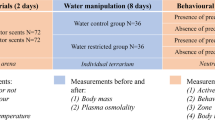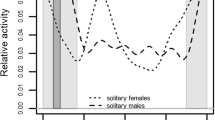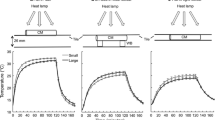Abstract
Huey and Slatkin’s (Q Rev Biol 51:363–384, 1976) cost–benefit model of lizard thermoregulation predicts variation in thermoregulatory strategies (from active thermoregulation to thermoconformity) with respect to the costs and benefits of the thermoregulatory behaviour and the thermal quality of the environment. Although this framework has been widely employed in correlative field studies, experimental tests aiming to evaluate the model are scarce. We conducted laboratory experiments to see whether the common lizard Zootoca vivipara, an active and effective thermoregulator in the field, can alter its thermoregulatory behaviour in response to differences in perceived predation risk and food supply in a constant thermal environment. Predation risk and food supply were represented by chemical cues of a sympatric snake predator and the lizards’ food in the laboratory, respectively. We also compared males and postpartum females, which have different preferred or “target” body temperatures. Both sexes thermoregulated actively in all treatments. We detected sex-specific differences in the way lizards adjusted their accuracy of thermoregulation to the treatments: males were less accurate in the predation treatment, while no such effects were detected in females. Neither sex reacted to the food treatment. With regard to the two main types of thermoregulatory behaviour (activity and microhabitat selection), the treatments had no significant effects. However, postpartum females were more active than males in all treatments. Our results further stress that increasing physiological performance by active thermoregulation has high priority in lizard behaviour, but also shows that lizards can indeed shift their accuracy of thermoregulation in response to costs with possible immediate negative fitness effects (i.e. predation-caused mortality).


Similar content being viewed by others
References
Adolph SC (1990) Influence of behavioral thermoregulation on microhabitat use by two Sceloporus lizards. Ecology 71:315–327
Angilletta MJ Jr (2001) Thermal and physiological constraints on energy assimilation in a widespread lizard (Sceloporus undulatus). Ecology 82:3044–3056
Angilletta Jr MJ, Hill T, Robson MA (2002) Is physiological performance optimized by thermoregulatory behavior?: a case study of the eastern fence lizard, Sceloporus undulatus. J Therm Biol 27:199–204
Angilletta MJ Jr, Bennett AF, Guderley H, Navas CA, Seebacher F, Wilson RS (2006) Coadaptation: a unifying principle in evolutionary thermal biology. Physiol Biochem Zool 79:282–294
Avery RA (1970) Utilization of caudal fat by hibernating common lizards, Lacerta vivipara. Comp Biochem Physiol 37:119–121
Avery RA, Mynott A (1990) The effects of temperature on prey handling time in the common lizard, Lacerta vivipara. Amphibia–Reptilia 11:111–122
Avery RA, Bedford JD, Newcombe CD (1982) The role of thermoregulation in lizard biology: predatory efficiency in a temperate diurnal basker. Behav Ecol Sociobiol 11:262–267
Bakken GS, Santee WR, Erskine DJ (1985) Operative and standard operative temperatures: tools for thermal energetics studies. Am Zool 25:933–943
Bauwens D, Hertz PE, Castilla AM (1996) Thermoregulation in a lacertid lizard: the relative contributions of distinct behavioral mechanisms. Ecology 77:1818–1830
Belliure J, Carrascal LM, Diaz JA (1996) Covariation of thermal biology and foraging mode in two mediterranean lacertid lizards. Ecology 77:1163–1173
Bennett AF (1980) The thermal dependence of lizard behaviour. Anim Behav 28:752–762
Blouin-Demers G, Weatherhead PJ (2001) Thermal ecology of black rat snakes (Elaphe obsoleta) in a thermally challenging environment. Ecology 82:3025–3043
Blouin-Demers G, Nadeau P (2005) The cost–benefit model of thermoregulation does not predict lizard thermoregulatory behaviour. Ecology 86:560–566
Christian KA (1998) Thermoregulation by the short-horned lizard (Phrynosoma douglassi) at high elevation. J Therm Biol 23:395–399
Cooper WE Jr (1995) Foraging mode, prey chemical discrimination, and phylogeny in lizards. Anim Behav 50:973–985
Cooper WE Jr, Pérez-Mellado V (2001) Food chemical cues elicit general and population-specific effects on lingual and biting behaviors in the lacertid lizard Podarcis lilfordi. J Exp Zool 290:207–217
Cooper WE Jr, Pérez-Mellado V (2002) Responses to food chemicals by two insectivorous and one omnivorous species of lacertid lizards. Netherl J Zool 52:11–28
Cooper WE Jr, Al-Johany AM, Vitt LJ, Habegger JJ (2000) Responses to chemical cues from animal and plant foods by actively foraging insectivorous and omnivorous scincid lizards. J Exp Zool 287:327–339
Cooper WE Jr, Pérez-Mellado V, Vitt LJ, Budzynski B (2002) Cologne as a pungency control in tests of chemical discrimination: effets of concentration, brand, and simultaneous and sequential presentation. J Ethol 21:101–106
Cowles RB, Bogert CM (1944) A preliminary study of the thermal requirements of desert reptiles. Bull Am Mus Nat Hist 83:261–296
Díaz JA, Cabezas-Díaz S (2004) Seasonal variation in the contribution of different behavioural mechanisms to lizard thermoregulation. Funct Ecol 18:867–875
Downes S (2001) Trading heat and food for safety: costs of predator avoidance in a lizard. Ecology 82:2870–2881
Downes S, Shine R (1998) Heat, safety or solitude? Using habitat selection experiments to identify a lizard’s priorities. Anim Behav 55:1387–1396
Dzialowski EM (2005) Use of operative and standard operative temperature models in thermal biology. J Therm Biol 30:317–334
Gasc J-P, Cabela A, Crnobrnja-Isailovic J, Dolmen D, Grossenbacher K, Haffner P, Lescure J, Martens H, Martínez Rica JP, Maurin H, Oliveira ME, Sofianidou TS, Veith M, Zuiderwijk A (eds) (1997) Atlas of amphibians and reptiles in Europe. Societas Europea Herpetologica & Museum National d’Histoire Naturelle (IEGB/SPN), Paris, p 469
Gilchrist GW (1995) Specialists and generalists in changing environments. I. Fitness landscapes of thermal sensitivity. Am Nat 146:252–270
Gvoždik L (2002) To heat or to save time? Thermoregulation in the lizard Zootoca vivipara (Squamata: Lacertidae) in different thermal environments along an altitudinal gradient. Can J Zool 80:479–492
Gvoždik L, Castilla AM (2001) A comparative study of preferred body temperatures and critical thermal tolerance limits among populations of Zootoca vivipara (Squamata: Lacertidae) along an altitudinal gradient. J Herp 35:486–492
Herczeg G, Kovács T, Hettyey A, Merilä J (2003) To thermoconform or thermoregulate? An assessment of thermoregulation opportunities for the lizard Zootoca vivipara in the subarctic. Polar Biol 26:486–490
Herczeg G, Kovács T, Tóth T, Török J, Korsós Z, Merilä J (2004) Tail loss and thermoregulation in the common lizard Zootoca vivipara. Naturwissenschaften 91:485–488
Herczeg G, Gonda A, Saarikivi J, Merilä J (2006) Experimental support for the cost–benefit model of lizard thermoregulation. Behav Ecol Sociobiol 60:405–414
Herczeg G, Saarikivi J, Gonda A, Perälä J, Tuomola A, Merilä J (2007) Suboptimal thermoregulation by male adders (Vipera berus) after hibernation imposed by spermiogenesis. Biol J Linn Soc 92:19–27
Hertz PE, Huey RB (1981) Compensation for altitudinal changes in the thermal environment by some Anolis lizards on Hispaniola. Ecology 62:515–521
Hertz PE, Huey RB, Nevo E (1982) Fight versus flight—body temperature influences defensive responses of lizards. Anim Behav 30:676–679
Hertz PE, Huey RB, Stevenson RD (1993) Evaluating temperature regulation by field-active ectotherms: the fallacy of the inappropiate question. Am Nat 142:796–818
Huey RB (1974) Behavioral thermoregulation in lizards: importance of associated costs. Science 184:1001–1003
Huey RB (1982) Temperature, physiology and the ecology of reptiles. In: Gans C, Pough FH (eds) Biology of the reptilia, vol 12. Physiology C. Academic, London, pp 25–91
Huey RB, Slatkin M (1976) Cost and benefits of lizard thermoregulation. Q Rev Biol 51:363–384
Huey RB, Stevenson RD (1979) Integrating thermal physiology and ecology of ectotherms: a discussion of approaches. Am Zool 19:357–366
Huey RB, Bennett AF (1987) Phylogenetic studies of coadaptation: preferred temperatures versus optimal performance temperatures of lizards. Evolution 41:1098–1115
Huey RB, Hertz PE, Sinervo B (2003) Behavioral drive versus behavioral inertia in evolution: a null model approach. Am Nat 161:357–366
Le Galliard J-F, Le Bris M, Clobert J (2003) Timing of locomotor impairment and shift in thermal preferences during gravidity in a viviparous lizard. Funct Ecol 17:877–885
Littell RC, Milliken GA, Stroup WW, Wolfinger RD, Schabenberger O (2006) SAS for mixed models, 2nd edn. SAS Institute Inc., Cary, NC
Lorenzon P, Clobert J, Oppliger A, John-Adler H (1999) Effect of water constraint on growth rate, activity and body temperature of yearling common lizard (Lacerta vivipara). Oecologia 118:423–430
Luiselli L (1992) Reproductive success of melanistic adders: a new hypothesis and some considerations of Andrén and Nilson’s (1981) suggestions. Oikos 64:601–604
Madsen T, Shine R (1992) Determinants of reproductive success in female adders, Vipera berus. Oecologia 92:40–47
Rice WR (1989) Analyzing tables of statistical tests. Evolution 43:223–225
Sergeyev A (1939) The body temperature of reptiles in natural surroundings. Doklady Akademia Nauk SSSR 22:49–52
Shine R (1980) ‘Costs’of reproduction in reptiles. Oecologia 46:92–100
Shine R, Harlow P (1993) Maternal thermoregulation influences offspring viability in a viviparous lizard. Oecologia 96:122–127
Shine R, Kearney M (2001) Field studies of reptile thermoregulation: how well do physical models predict operative temperatures. Funct Ecol 15:282–288
Shine R, Harlow PS, Elphick MJ, Olsson MM, Mason RT (2000) Conflicts between courtship and thermoregulation: the thermal ecology of amorous male garter snakes (Thamnophis sirtalis parietalis, Colubridae). Physiol Biochem Zool 73:508–516
Shine R, Sun L-X, Kearney M, Fitzgerald M (2002) Thermal correlates of foraging-site selection by Chinese pit-vipers (Gloydius shedaoensis, Viperidae). J Therm Biol 27:405–412
Sinervo B, Adolph SC (1994) Growth plasticity and thermal opportunity in Sceloporus lizards. Ecology 75:776–790
Stevenson RD (1985a) The relative importance of behavioral and physiological adjustments controlling body temperature in terrestrial ectotherms. Am Nat 126:362–386
Stevenson RD (1985b) Body size and limits to the daily range of body temperature in terrestrial ectotherms. Am Nat 125:102–117
Thoen C, Bauwens D, Verheyen RF (1986) Chemoreceptive and behavioural responses of the common lizard Lacerta vivipara to snake chemical deposits. Anim Behav 34:1805–1813
Uller T, Olsson M (2003) Life in the land of the midnight sun: are northern lizards adapted to longer days? Oikos 101:317–322
Van Damme R, Bauwens D, Verheyen RF (1987) Thermoregulatory responses to environmental seasonality by the lizard Lacerta vivipara. Herpetologica 43:405–415
Van Damme R, Bauwens D, Verheyen RF (1990a) Evolutionary rigidity of thermal physiology: the case of cool temperate lizard Lacerta vivipara. Oikos 57:61–67
Van Damme R, Bauwens D, Verheyen RF (1991) The thermal dependence of feeding behaviour, food consumption and gut-passage time in the lizard Lacerta vivipara Jacquin. Funct Ecol 5:507–517
Van Damme R, Bauwens D, Vanderstighelen D, Verheyen RF (1990b) Responses of the lizard Lacerta vivipara to predator chemical cues: the effect of temperature. Anim Behav 40:298–305
Van Damme R, Bauwens D, Thoen C, Vanderstighelen D, Verheyen RF (1995) Responses of naïve lizards to predator chemical cues. J Herp 29:38–43
Vitt LJ, Sartorius SS (1999) HOBOs, Tidbits and lizard models: the utility of electronic devices in field studies of ectotherm thermoregulation. Funct Ecol 13:670–674
Walsberg GE, Wolf BO (1996) A test of the accuracy of operative temperature thermometers for studies of small ectotherms. J Therm Biol 21:275–281
Withers PC, Campbell JD (1985) Effects of environmental cost on thermoregulation in the desert iguana. Physiol Zool 58:329–339
Acknowledgments
Our study was supported by the Academy of Finland (GH & JM). We collected the lizards with permission (LUO403). The experiments were done under the license of the Helsinki University Animal Experimentation Committee (HY126-06). We are highly indebted to Raymond Huey for his scientific and Michael Hardman for his linguistic comments. We also thank Michael Angilletta and an anonymous referee for their constructive comments. The experiments in the present study comply with the current laws of Finland.
Author information
Authors and Affiliations
Corresponding author
Additional information
Communicated by Roland Brandl.
Rights and permissions
About this article
Cite this article
Herczeg, G., Herrero, A., Saarikivi, J. et al. Experimental support for the cost–benefit model of lizard thermoregulation: the effects of predation risk and food supply. Oecologia 155, 1–10 (2008). https://doi.org/10.1007/s00442-007-0886-9
Received:
Accepted:
Published:
Issue Date:
DOI: https://doi.org/10.1007/s00442-007-0886-9




